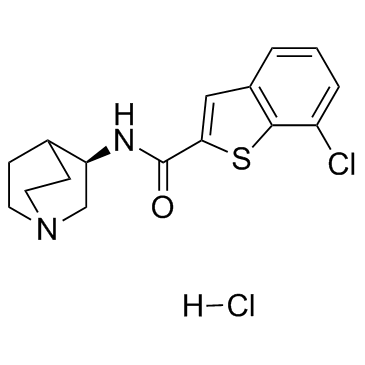| Description |
Encenicline hydrochloride (EVP-6124 hydrochloride) is a novel partial agonist of α7 neuronal nicotinic acetylcholine receptors (nAChRs).
|
| Related Catalog |
|
| Target |
α7 nAChR[1]
|
| In Vitro |
Encenicline (EVP-6124) displaces [3H]-MLA (Methyllycaconitine) (Ki=9.98 nM, pIC50=7.65±0.06, n=3) and [125I]-α-bungarotoxin (Ki=4.33 nM, pIC50=8.07±0.04, n=3). Encenicline (EVP-6124) is approximately 300 fold more potent than the natural agonist ACh (Ki=3 μM), measured in binding assays using [3H]-MLA. Encenicline hydrochloride inhibits the 5-HT3 receptor by 51% at 10 nM, the lowest concentration tested. Evaluation of the human 5-HT2B receptor expressed in CHO cells demonstrates displacement of [3H]-mesulergine (Ki=14 nM) and only antagonist activity in the rat gastric fundus assay at an IC50 of 16 μM. In binding and functional experiments, Encenicline (EVP-6124) shows selectivity for α7 nAChRs and does not activate or inhibit heteromeric α4β2 nAChRs[1].
|
| In Vivo |
Encenicline hydrochloride has good brain penetration and an adequate exposure time. Encenicline hydrochloride (0.3 mg/kg, p.o.) significantly restores memory function in scopolamine-treated rats (0.1 mg/kg, i.p.) in an object recognition task (ORT). Although donepezil at 0.1 mg/kg, p.o. or Encenicline hydrochloride at 0.03 mg/kg, p.o. did not improve memory in this task, co-administration of these sub-efficacious doses fully restored memory. In a natural forgetting test, an ORT with a 24 h retention time, Encenicline hydrochloride improved memory at 0.3 mg/kg, p.o. This improvement is blocked by the selective α7 nAChR antagonist methyllycaconitine (0.3 mg/kg, i.p. or 10 μg, i.c.v.). Encenicline hydrochloride is found to bind moderately to rat plasma proteins with a mean fu of 0.11±0.01 (mean±SD) or 11%. Over a range of 0.1-30 mg/kg, p.o., Encenicline hydrochloride demonstrates proportional dose escalation. Tmax is at 4 h in plasma and 2 h brain, although the brain concentrations remained similar between 2 and 8 h. The B:P ratios are 1.7-5.1 between 1 and 8 h[1]. Pharmacokinetic studies have shown that Encenicline hydrochloride (0.4 mg/kg, i.p.) reaches peak brain concentration 2 hr after administration and remains at effective concentrations for at least 4 hr. Encenicline hydrochloride is administered to WT mice at ZT0 (0.4 mg/kg i.p single dose) and significantly increases the saturation index of NMDARs in slices obtained 4 hr later without causing prolonged wakefulness or enhanced locomotor activity [2].
|
| Animal Admin |
Rats[1] Twenty-four 2.5-month-old male Wistar rats (average body weight: 329 g) are used. Before testing EVP-6124, the effects of scopolamine alone at 0.03, 0.1, or 0.3 mg/kg, i.p. in the ORT are determined (n=8 per treatment). Scopolamine (0.1 mg/kg, i.p.) injected 30 min before T1 resulted in a robust deficit at T2 when a 1 h interval is used. The d2 index is not significantly different from the chance level of performance; and there are no changes in exploratory behavior for 0.1 mg/kg, i.p. of scopolamine compared with saline. Subsequently, the ability of Encenicline (EVP-6124) to reverse the memory impairment induced by 0.1 mg/kg of scopolamine is tested. First, scopolamine and then Encenicline (EVP-6124) (0.03, 0.1, 0.3, and 1.0 mg/kg, p.o.) are administered 30 min before T1. For the control treatments, animals received either deionized water (p.o.) plus saline (i.p.) or deionized water (p.o.) plus 0.1 mg/kg scopolamine (i.p.). Mice[2] Adult male mice (3-6 months old) are used throughout this study. Encenicline (EVP-6124) is injected i.p. (0.4 mg/kg) at Zeitgeber time (ZT0) in awake mice (9 mice total for this experiment), in the animal facility. Mice are then immediately returned to their home cage with their siblings and left undisturbed for 4 hr (ZT4). During this time, they are closely monitored to check for possible behavioral effects of Encenicline (EVP-6124) injection. All of the 9 injected mice nested and are immobile in the hour following the injection.
|
| References |
[1]. Prickaerts J, et al. EVP-6124, a novel and selective α7 nicotinic acetylcholine receptor partial agonist, improves memory performance by potentiating the acetylcholine response of α7 nicotinic acetylcholine receptors. Neuropharmacology. 2012 Feb;62(2):109 [2]. Thomas Papouin, et al. Septal Cholinergic Neuromodulation Tunes the Astrocyte-Dependent Gating of Hippocampal NMDA Receptors to Wakefulness. Neuron. 2017 May 17;94:1-15. [3]. Papouin T, et al. Septal Cholinergic Neuromodulation Tunes the Astrocyte-Dependent Gating of Hippocampal NMDA Receptors to Wakefulness. Neuron. 2017 May 17;94(4):840-854.e7. [4]. Maehara S, et al. Pharmacological characterization of a novel potent, selective, and orally active phosphodiesterase 2A inhibitor, PDM-631. Eur J Pharmacol. 2017 Sep 15;811:110-116.
|
